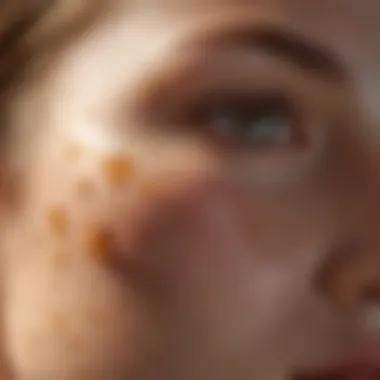Eliminating Sun Spots: A Comprehensive Guide


Intro
Understanding the impact of sun exposure on skin health is essential. Sun spots, often referred to as liver spots or solar lentigines, appear as small, brownish patches on the skin due to prolonged UV exposure. While they generally pose no health threat, many seek to eliminate them for cosmetic reasons. This article presents a detailed exploration of strategies to combat sun spots effectively, covering prevention, treatment, and lifestyle modifications.
The importance of discussing sun spots lies in their wide-spread occurrence among diverse demographics. As beauty trends evolve, a growing focus on flawless skin has emerged. Thus, awareness and knowledge about sun spots become vital for those concerned with skin appearance and integrity.
By delving into this subject, we aim to equip readers with actionable insights. This guide is tailored for beauty enthusiasts looking to make informed decisions in treating and preventing sun spots. Moreover, understanding these aspects can promote healthier skin care practices and enhance overall beauty.
Preventive Measures
Preventing sun spots is always better than treating them later. The first line of defense is effective sun protection:
- Sunscreen Usage: Apply a broad-spectrum sunscreen with at least SPF 30 daily. This shields the skin from UV rays, significantly reducing the risk of sun spots.
- Protective Clothing: Wearing hats and long-sleeve shirts can provide additional barriers against the sun.
- Avoiding Peak Hours: Try to limit sun exposure during peak hours, typically between 10 a.m. and 4 p.m.
Adopting these preventive measures not only maintains skin health but also enhances the effectiveness of future treatments.
Topical Treatments
When it comes to eliminating sun spots, several topical treatments show promise:
- Hydroquinone: This skin-lightening agent is commonly used to diminish dark spots. Consult a dermatologist before use, as it may cause irritation.
- Retinoids: Products containing retinoic acid can promote cell turnover, helping to fade sun spots over time.
- Vitamin C: Known for its antioxidant properties, Vitamin C can brighten the skin and reduce pigmentation.
Regular application of these treatments can lead to noticeable improvements in skin tone and texture.
Professional Interventions
If topical treatments fall short, professional methods offer effective alternatives:
- Chemical Peels: These procedures involve applying acidic solutions to remove the outer layers of skin, promoting a more even complexion.
- Laser Therapy: Targeted laser treatments can effectively break up pigmented cells, reducing the appearance of sun spots.
- Microdermabrasion: A less invasive option, this technique exfoliates the skin, helping to fade discoloration gradually.
Seeking professional help ensures tailored solutions based on individual skin types and conditions.
Lifestyle Adjustments
Beyond creams and procedures, lifestyle choices play a crucial role in promoting skin health:
- Balanced Diet: Consuming foods rich in antioxidants, such as fruits and vegetables, supports skin regeneration.
- Hydration: Keeping the skin moisturized helps maintain its barrier function, improving overall appearance.
- Adequate Sleep: Quality sleep allows for natural skin repair and rejuvenation.
Culmination
Sun spots may affect personal aesthetics, but numerous effective strategies exist for their elimination. From proactive prevention to innovative treatments, informed choices lead to healthier skin. Understanding one's skin type and individual needs is crucial for achieving the best results. Each person's journey in addressing sun spots is unique; thus, knowledge and care pave the way for maintaining beautiful skin.
Understanding Sun Spots
Understanding sun spots is crucial when tackling skin pigmentation issues. These blotches can be a concern for many individuals as they can affect not only appearance but also overall skin health. In this section, we will highlight key points surrounding sun spots, their formation, and why it is important to understand them for effective management and prevention.
What are Sun Spots?
Sun spots, also known as solar lentigines or age spots, are flat brown, gray, or black spots that occur on sun-exposed areas of the skin. They result from the skin’s increased production of melanin, which is the pigment that gives color to the skin. These spots typically appear in areas such as the face, hands, shoulders, and arms. They vary in size and shape and are often more prominent in older individuals due to cumulative sun exposure over time.
Causes of Sun Spots
The primary cause of sun spots is prolonged exposure to ultraviolet (UV) radiation from the sun. These rays can damage skin cells, leading to an increase in melanin production as a natural defense mechanism. Other factors that can contribute to the formation of sun spots include:
- Genetic predisposition: Some individuals may be more prone to sun spots due to their genetic makeup.
- Hormonal changes: Hormonal fluctuations, particularly during pregnancy or from contraceptive use, can increase sun spot intensity.
- Certain medications: Some drugs can increase skin sensitivity to sunlight, making it easier for sun spots to develop.
Skin Types and Sun Spot Formation
Understanding how different skin types react to sun exposure is essential in preventing sun spots. Skin is often categorized into skin types I through VI based on the Fitzpatrick scale.
- Type I: Very fair skin, often burns and rarely tans. More prone to sun spots.
- Type II: Fair skin, usually burns but might tan slightly.
- Type III: Medium skin, may burn but tans more easily.
- Type IV: Olive skin, burns moderately but tans well.
- Type V: Brown skin, rarely burns and tans easily.
- Type VI: Dark brown or black skin, almost never burns and tans quickly.


Individuals with lighter skin types tend to develop sun spots more readily. However, anyone can develop these pigmentation changes through sufficient sun exposure.
Ensure you protect your skin to prevent sun spots, regardless of your skin type.
Prevention Strategies
Preventing sun spots is crucial for maintaining skin health and appearance. The impact of UV exposure on skin pigmentation underscores the necessity to employ effective prevention strategies. Understanding these approaches can safeguard against the damaging effects of the sun while promoting a more even skin tone. Moreover, preventing sun spots is often simpler and more cost-effective than attempting to treat them after they appear.
Understanding UV Radiation
Ultraviolet (UV) radiation is a major contributor to skin damage. It is primarily divided into two categories: UVA and UVB rays. UVA rays penetrate deep into the skin and are responsible for long-term skin damage, including premature aging and the formation of sun spots. In contrast, UVB rays primarily affect the surface layer, leading to sunburn. Both types of UV radiation can contribute to skin cancer.
It is necessary to understand that UV rays are present even on cloudy days or during winter. They can reflect off surfaces like water, sand, and snow, thus increasing exposure. To combat the detrimental effects of UV radiation, a comprehensive understanding of its presence and impact is key.
Daily Sun Protection Tips
Adopting daily sun protection strategies is essential for minimizing the risk of developing sun spots. Here are several effective practices:
- Use sunblock: Apply a broad-spectrum sunscreen with an SPF of at least 30 daily, even on cloudy days. This helps block both UVA and UVB rays.
- Reapply: Sunscreen should be reapplied every two hours, especially after sweating or swimming.
- Seek shade: During peak sun hours (10 AM to 4 PM), try to stay in shaded areas whenever possible.
- Stay aware of the UV index: Keep an eye on the daily UV index to gauge the strength of the sun’s rays. Awareness can guide outdoor plans.
"Daily use of sunscreen can reduce the risk of developing skin cancer and premature aging, especially for those prone to sun spots."
The Role of Clothing and Accessories
Clothing and accessories play a significant role in protecting the skin from sun exposure. Opting for protective clothing can provide a barrier against harmful UV rays. Consider these points when selecting apparel:
- Wear UPF-rated clothing: Clothing labeled with a UPF (Ultraviolet Protection Factor) rating offers enhanced UV protection.
- Choose tightly woven fabrics: These fabrics block more UV rays compared to lighter or loosely woven materials.
- Accessorize wisely: Hats with wide brims and sunglasses can shield the face and eyes from direct sunlight. Choose sunglasses that block 100% of UV rays.
- Layering is beneficial: Wearing multiple layers can provide additional protection while allowing flexibility in comfort depending on temperature.
Incorporating these preventive strategies can significantly reduce the risk of sun spots, leading to healthier and more resilient skin.
Topical Treatments
Topical treatments play an essential role in addressing sun spots, offering various methods for those looking to brighten their complexion. These treatments can help in reducing the appearance of hyperpigmentation that often results from sun exposure. The benefits of topical applications include convenience, targeted action, and a range of options suitable for different skin types. Therefore, understanding these treatments is crucial for anyone striving to improve their skin's health and appearance.
Over-the-Counter Creams
Over-the-counter creams are widely used for their accessibility and affordability. Many of these products contain active ingredients that target sun spots effectively. Common ingredients found in these creams include hydroquinone, glycolic acid, and vitamin C.
- Hydroquinone is known for its ability to lighten darkened areas of skin. It works by inhibiting melanin production.
- Glycolic acid is an alpha hydroxy acid that exfoliates the skin, promoting cell turnover. This helps in fading sun spots gradually.
- Vitamin C provides antioxidant protection and assists in brightening the skin tone.
Using these creams regularly as part of a skincare routine can yield significant improvements. It's important to follow the instructions and apply sunscreen during the day, as some ingredients can increase sensitivity to the sun.
Prescription Treatments
While over-the-counter options are beneficial, prescription treatments may provide more potent solutions for stubborn sun spots. Dermatologists often recommend these after assessing skin type and conditions. Common prescription treatments include stronger formulations of hydroquinone and topical retinoids.
- Prescription hydroquinone can be more effective due to its higher concentration. This allows for a more aggressive treatment of pigmentation issues.
- Topical retinoids, like tretinoin, promote faster skin cell turnover. They help in minimizing the visibility of sun spots and prevent future formation.
Consultation with a dermatologist is necessary before starting these treatments to evaluate potential side effects and ensure the suitability for your skin type.
Natural Remedies and Their Efficacy
Natural remedies have gained popularity as a gentler approach to treating sun spots. While the efficacy of these treatments may vary, many people seek them due to fewer side effects compared to chemical options. Some common natural remedies include aloe vera, licorice extract, and green tea.
- Aloe vera has been studied for its skin-soothing properties and potential to lighten dark spots over time.
- Licorice extract contains glabridin, which can help in reducing melanin production.
- Green tea is rich in antioxidants that provide general skin health benefits and may contribute to fading spots.
Choosing natural remedies often requires patience and consistent use; results may not be immediate. They work best as part of a wider skincare approach that includes sun protection and general skin care.
Professional Treatments
Professional treatments play a crucial role in managing sun spots effectively. While over-the-counter solutions exist, they may not always provide the desired results. Professional interventions are designed to yield quicker and more substantial outcomes under the guidance of skincare professionals. This section will discuss three principal types: chemical peels, laser therapy, and intense pulsed light therapy. Each method has unique features, benefits, and considerations, making it essential to understand them fully when seeking treatment.
Chemical Peels


Chemical peels involve applying a solution to the skin that causes the top layers to exfoliate and eventually peel off. This treatment is effective for reducing sun spots as it promotes new skin growth that is often free of pigmentation issues.
There are three main types of chemical peels:
- Superficial Peels: These are mild and often use alpha-hydroxy acids. They gently exfoliate the outer layer of skin and require minimal downtime, making them a good option for first-time users.
- Medium Peels: These typically use trichloroacetic acid and penetrate deeper into the skin. It can address more significant pigmentation problems but may require a few days of recovery.
- Deep Peels: These are the strongest and use phenol to treat severe age spots. They provide dramatic results and may necessitate a longer recovery time.
Before undergoing a chemical peel, consultation with a dermatologist is advised, to select the right type for your skin type and pigmentation issues.
Laser Therapy
Laser therapy offers a targeted approach to treating sun spots. By utilizing specific wavelengths of light, this method targets melanin directly. The body then naturally eliminates the treated skin cells, leading to clearer skin over time.
Different types of laser therapy exist, such as:
- Ablative Lasers: Which remove layers of skin and are effective for extensive damage but require longer recovery.
- Non-Ablative Lasers: These preserve the skin's surface and promote collagen production, being suitable for a variety of skin tones and concerns.
The primary advantage of laser therapy is its precision, allowing for tailored treatments according to individual skin needs. Patients often experience minimal discomfort and quick recovery.
Intense Pulsed Light Therapy
Intense pulsed light therapy, often referred to as IPL, utilizes broad-spectrum light for skin treatment. Unlike lasers that focus on a single wavelength, IPL disperses multiple wavelengths, making it effective for various pigmentation concerns, including sun spots.
This process works by heating the targeted skin tissue, causing pigmentation to dissolve without affecting the surrounding areas. The benefits of IPL include:
- Minimal Downtime: Most individuals can return to their daily activities immediately after treatment.
- Versatility: IPL can also treat other skin issues like redness and broken capillaries, making it a multi-functional treatment option.
As with any professional treatment, discussing the potential risks and expected outcomes with a licensed professional is essential. This ensures the treatment aligns with your skin type and addresses your specific issues effectively.
In summary, professional treatments are indispensable for those seeking substantial improvement in their skin's appearance concerning sun spots. Each method has its distinct advantages and considerations, making it necessary to assess them based on individual needs.
Lifestyle Adjustments
Lifestyle adjustments can play a critical role in managing sun spots and enhancing overall skin health. Often overshadowed by skincare products and professional treatments, these changes can be equally, if not more, significant. Emphasizing a holistic approach, this section explains the importance of specific lifestyle elements such as nutrition, hydration, and stress management, all of which contribute to the skin's resilience against sun damage.
Nutrition and Skin Health
Nutrition forms the bedrock of skin health. A balanced diet rich in antioxidants is vital. Fruits and vegetables such as berries, spinach, and carrots should be staples. These foods help combat oxidative stress caused by sun exposure.
Including omega-3 fatty acids, found in fish like salmon and in walnuts, supports skin barrier function and can mitigate inflammation. Vitamin C, present in citrus fruits, is crucial for collagen formation, enhancing skin repair.
To modify dietary habits:
- Increase consumption of colorful fruits and vegetables.
- Incorporate healthy fats into daily meals.
- Limit processed foods high in sugar and unhealthy fats.
Adopting these practices can strengthen skin, making it less prone to damage and more capable of healing.
Hydration and Its Importance
Hydration is often overlooked yet essential for skin health. Adequate water intake helps maintain skin's elasticity and promotes cellular function. It flushes out toxins that can contribute to skin issues, including pigmentation.
Studies suggest that drinking enough water can improve skin hydration, resulting in a plumper, healthier appearance. The recommended amount is about eight glasses per day, but it may vary based on activity levels and climate conditions.
To stay hydrated, consider these strategies:
- Carry a reusable water bottle to track intake.
- Infuse water with fruits or herbs for flavor.
- Monitor urine color; light yellow indicates proper hydration.
Being consistently hydrated can reduce the risk of developing sun spots and support overall skin health.
Stress Management Techniques
Stress impacts skin health. High levels of stress can exacerbate skin issues, leading to increased pigmentation and accelerated aging. Finding effective stress management techniques can provide significant benefits.


Methods to manage stress include:
- Practicing mindfulness and meditation to cultivate inner calm.
- Engaging in regular physical activity, which releases endorphins and reduces stress.
- Setting aside time for hobbies and relaxation to promote overall well-being.
Incorporating these techniques into daily life can not only enhance mental health but also yield visible improvements in the skin's appearance.
"Your skin often reflects your internal health and emotional state. Taking care of your mental health can translate into healthier skin."
Putting focus on these lifestyle adjustments can yield long-lasting benefits. Nutrition, hydration, and stress management contribute to healthier skin, aiding in the fight against sun spots and enhancing the skin’s natural glow.
Evaluating Results
Evaluating results is a crucial aspect of eliminating sun spots. It involves monitoring the effectiveness of your chosen treatments and understanding how your skin is responding. The importance of this evaluation cannot be overstated; it ensures that you are making informed decisions about your skincare regimen and can help you avoid wasting time and resources on ineffective methods.
Effective evaluation includes a combination of visual assessment and possibly keeping a diary of changes. Regularly scanning your skin for any alterations in the appearance of sun spots is beneficial. This process allows you to discern whether the treatments you are applying are yielding the desired outcomes. Additionally, it fosters a deeper connection between you and your skin's health, promoting proactive care rather than reactive measures.
Key Benefits of Evaluating Results:
- Track Progress: Clearly see improvements or any setbacks with specific treatments.
- Informed Decisions: Adjust your approach based on concrete observations rather than assumptions.
- Optimal Treatments: Identify which products or treatments are most effective, allowing you to invest more in them.
Moreover, understanding the timeline for visible results is essential. Some treatments may take weeks or even months to show significant effects. Patience is key, however, evaluating your skin throughout this period will help you stay focused on your goals.
Monitoring Skin Changes
Monitoring skin changes is vital in the journey to eliminate sun spots. Regular observation allows for early detection of improvements or aggravations in your skin's condition. Each person's skin can respond differently to sunscreens, creams, or treatments, making it imperative to track these changes closely.
Use a journal to log your routine, including products used, duration, and conditions like sun exposure. Document the size, color, and number of sun spots. This simple practice can indicate patterns and help assess which treatments work best for you.
Consider taking photos every few weeks under the same lighting conditions to visualize your progress visually. This creates a more objective assessment of your skin’s evolution over time.
"Your skin is a reflection of your overall health. Monitoring changes helps you to make the best choices for it."
Keeping a watchful eye is not only about noticing imperfections but also recognizing improvements, enabling a more tailored skincare routine.
When to Consult a Dermatologist
While self-monitoring is beneficial, there are instances where the insight of a dermatologist becomes necessary. Consulting a professional is imperative if you notice
- sudden changes in sun spots,
- new growths,
- or if existing spots begin to itch, bleed, or change in color.
A dermatologist can perform a comprehensive evaluation, offering advanced treatments and recommendations based on your unique skin type and condition. Their expertise goes beyond mere observation; they can provide guidance on appropriate medications and procedures, such as chemical peels or laser treatments, that might be suitable.
Be sure to prepare for your appointment by bringing along notes from your monitoring efforts. This can help the dermatologist understand your skin's history and guide their diagnosis and treatment recommendations.
Regular skin evaluations contribute to better skincare outcomes. Ultimately, understanding when to consult a professional enhances your approach to managing sun spots effectively.
End and Final Thoughts
Understanding how to eliminate sun spots is not just about recognizing their existence on our skin. It is crucial to appreciate the comprehensive nature of this journey. The methods discussed throughout this article, ranging from prevention strategies to various treatment options, provide readers with a myriad of tools to combat sun spots effectively. This holistic approach acknowledges that sun spots do not merely signify cosmetic issues; they are also indicators of wider concerns about skin health and long-term wellbeing.
Summarizing Effective Strategies
In summary, several effective strategies can be employed in the battle against sun spots. Prevention should always be the first line of defense. Using broad-spectrum sunscreen daily, wearing protective clothing, and avoiding sun exposure during peak hours can greatly reduce the likelihood of developing these blemishes.
For those who already have sun spots, topical treatments present numerous options. Over-the-counter creams containing hydroquinone or retinoids can lighten existing sun spots while prescription options may offer stronger formulations for stubborn cases. Additionally, natural remedies, such as those derived from licorice and green tea, can be beneficial, although their efficacy varies among individuals.
Moreover, professional treatments, including chemical peels, laser therapy, and intense pulsed light therapy, offer advanced solutions for more serious instances of sun spots. Such treatments should always be explored in consultation with a qualified dermatologist, ensuring a tailored approach based on skin type and specific needs.
Emphasizing Preventive Care
Preventive care remains a fundamental aspect of effective sun spot management. Establishing a daily skin care routine that centers around sun protection can safeguard one's skin over time. This includes selecting a high SPF sunscreen that is often reapplied when necessary, particularly during outdoor activities. Additionally, routine skin checks can create awareness and prompt early action if new spots appear or existing ones change.
Incorporating skin-friendly practices, such as a balanced diet rich in antioxidants and staying well-hydrated, can aid the skin's overall health and resilience against sun damage.
Ultimately, the commitment to preventing sun spots through informed skincare routines and lifestyle adjustments contributes significantly to healthier skin in the long term. Knowledge empowers decisions, and by following a proactive approach, one can significantly diminish the impact of environmental factors on skin wellbeing.
"Investing in skin care today reaps benefits for tomorrow."
By integrating preventive care into everyday life, individuals can mitigate the effects of sun exposure, leading to a radiant and more youthful complexion.















